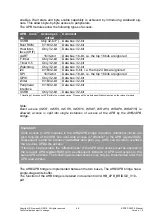
Copyright © Siemens AG 2016. All rights reserved
60
ERTEC 200P-2 Manual
Technical data subject to change
Version 1.0
All incoming interrupts are synchronized in two stages to the operating clock of the ICU. It
must be guaranteed that interrupts at the asynchronous inputs must remain at least two
clocks of the operating clock so they can be reliably detected by the ICU.
Note: All level triggered interrupts has to be high active. Low Active level triggered
interrupts are not supported by ICU and must be inverted on ERTEC 200P toplevel.
The CPU can use the DBG_ACK signal (coming from ARM926-Core) to permit direct
throughput to the global Enable Bit of all interrupts in the ICU. Because this signal comes
from the CPU, and thus from another clock domain, the signal in the ICU is synchronized
twice to the operating clock.
2.3.2.13.2 Bus interface
The ICU contains a standard AHB slave interface working in accordance with the AHB
Lite protocol. The data width is 32 bits. Word, halfword and byte accesses are permitted.
Bursts are commuted into single accesses.
The signals HPROT and HMASTLOCK are not evaluated. The bus interface of the ICU
carries out one wait state in maximum for reads. For writes no wait state is performed.
The ICU performs no error response at all.
2.3.2.13.3 Sequences
The following is a typical interrupt cycle:
1. A valid interrupt is pending at the input. Valid here means that the correct edge has
been detected (assuming: edge-triggering activated) and the interrupt has not been
entered in the interrupt request register yet.
2. This interrupt is then entered in the interrupt request register.
3. Before this interrupt now takes part in the priority logic, it is checked if it is masked.
If it is not and if the interrupt locking feature is deactivated, the interrupt takes part
in the priority check. At the end of the priority check, the interrupt - or its number -
which is active and has the highest priority is displayed. If there is no interrupt
pending, the priority check does not display anything.
4. It is then checked if this interrupt with the currently highest priority has a higher pri-
ority than the one which might currently be processed – i.e. which is "in service". If
the pending interrupt has a higher priority, the ICU activates the interrupt output in
the direction of the CPU.
This means that the CPU recognizes an exception at the interrupt input and executes its
interrupt service routine:
5. The INTAACK register is read, which indicates the interrupt that currently has the
highest priority and wants to interrupt the CPU.
6. The reading of the INTAACK register triggers an acknowledge process in the ICU
in which the set bit is deleted from the interrupt register and entered (set) in the in-
service register. The ICU memorizes internally that this interrupt is currently pro-
cessed. The ICU even memorizes the sequence in which the interrupts have been
acknowledged in the case of nested interrupts or several interrupts occurring simul-
taneously. This is mandatory since the CPU issues an end-of-interrupt command
after the execution of the interrupt service routine, by carrying out a write access to
Содержание ERTEC 200P
Страница 1: ...ERTEC 200P 2 Enhanced Real Time Ethernet Controller Manual ...
Страница 309: ...Copyright Siemens AG 2016 All rights reserved 309 ERTEC 200P 2 Manual Technical data subject to change Version 1 0 ...
Страница 492: ...Copyright Siemens AG 2016 All rights reserved 492 ERTEC 200P 2 Manual Technical data subject to change Version 1 0 ...
















































